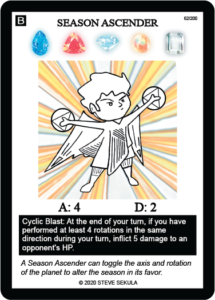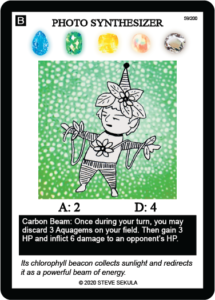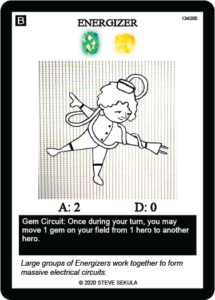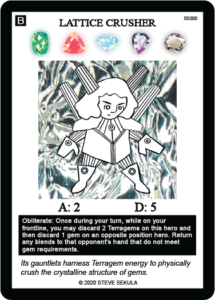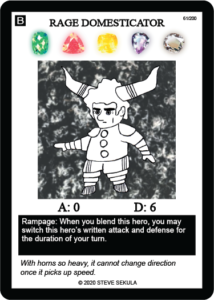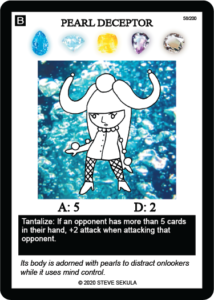Greetings from Belgium, and good morning, afternoon, or evening, depending on where you are! Today I will dive a little deeper into how to choose what gems you should add to your deck. Since we’re talking about gems here, it’s worth noting that the wrong number or type of gem in your deck can easily turn the tide of the game from a glorious victory to a shameful defeat.
ONE GEM, TWO GEM? RED GEM, BLUE GEM?
The name “Gem Blenders” contains the two most crucial factors you must consider when making a deck: gems and blends. And before you even think about your gem makeup, you should always start building your deck with a specific blend in mind — preferably a LV. 5 one. Once you’ve figured out your seed blend, you should start looking for sub-blends. These are blends that use a subset of the combination of gems that make up your LV. 5 blend. Once this is done, you can start adding the right gems to your deck.
Let’s dive right in: I’ll give you some blends in a deck and then show you how I think about adding their supporting gems.
Example #1: You have a deck containing Season Ascender, Fog Shifter, and Shifter. Not optimal: You add all five gems equally to your deck. This would result in an excess of drawn Aerogems and Cryogems, because Fog Shifter and Shifter don’t need those gems. Drawing the wrong gems for the blends you already have in your hand will slow down your strategy. Optimal: You add gems based on how often they appear in the blends you chose. Let’s see how this plays out in our example. We can see that Aquagems and Luciogems appear in all three blends, Pyrogems appear in only two of the three, and Aerogems and Cryogems are only useful for Season Ascender. Based on these observations, a more practical gem count would be 5 Aquagems, 5 Luciogems, 4 Pyrogems, 3 Aerogems, and 3 Cryogems.
TL;DR: The number of gems in your deck should be proportional to the frequency with which they appear in your blends.
Example #2: Your next deck has two goals. First, you want to take advantage of the synergy between Photo Synthesizer and Milk Herald. Second, you want to keep the gem count in your deck as low as you can. Not optimal: One way to reduce the number of gems you use in a deck is to make sure you can move gems around on your field as needed. Enter the obvious choice: the Photo Synthesizer sub-blend, Energizer. But there’s a catch! If you apply the principle of including gems based on how often they appear in your blends, you would still end up with many copies of all five gems, since Milk Herald and Energizer have no gems in common. With Energizer, you might actually be increasing the number of gems in your deck! Optimal: A more gem-efficient solution is to put a Francisco on your bench, or even put a few copies of Transfer in your deck, leaving you with no abundance of Terragems and Electrogems.
TL;DR: While some blend effects help minimize gems, don’t discount the gems you’ll need to play those blends in the first place!
At this point you’re probably wondering: Why do you need more than one gem copy for each blend that uses it?
For that Example #1 deck, say you decide to only add one Aerogem and one Cryogem to your deck, since you only plan to put out one Season Ascender on the field. Unfortunately, disaster strikes! Your opponent has what’s known as “gem disruption” in their deck! Cards like Drain and Lattice Crusher can ruin your whole combo if you aren’t careful! Stick to having multiple copies of each gem. It’ll leave you with room to breathe and time to respond to gem disruption.
DECKS WITH MORE THAN 5 GEM TYPES — IS IT REALLY WORTH IT?
It is generally considered suboptimal for a deck to have more than five different gem types. Unless you have an easy way to search gems in your deck, this has some truth to it — getting the right gems will become increasingly difficult near the endgame because you won’t have any resources left to go looking for them. Therefore, the rule of thumb is to build a deck based on one particular LV. 5 blend so any drawn gem will have its purpose in the game.
However, there are ways to get around this limitation for those strategies that justify the use of six or more gem types. Let’s look at some scenarios to see how this would work.
Example #1: You want to boost your chances of finding the right gems to play a Rage Domesticator. Not optimal: You put extra copies of all of Rage Domesticator’s gems in your deck. These added gems equate to wasted room for disruption or general supporting cards, and also force you to draw unwanted gems toward the endgame. Optimal: You add one Luciogem and three Bishops in combination with a hero such as Judith. Use Judith to grab the Luciogem on your first turn. Now you will have the right gems to play your Bishop, and can use its effect to find Rage’s gems (and look for an appropriate LV. 3 to adapt to your current situation).
TL;DR: If you add a sixth gem type for a blend that assists your deck, don’t add too many copies – make them count!
Example #2: You are looking for early Hornet aggression in a Pearl Deceptor deck. This requires seven different gem types. Not optimal: With seven gem types in your deck, your early game strategy would be to search however you can for Hornets and their gems to get them on the field as fast as possible. After this process you’d end up with a huge advantage in damage given, but you’d also be stuck with two useless gem types on the field and reduced options to search for the right gems for a Pearl Deceptor. Optimal: The best way to approach two disparate sets of gem types is to use a bridging blend like Cone, which shares a Terragem with Hornet and a Cryogem with Pearl Deceptor. If you play a Cone first, you’ll be one turn slower to play a Hornet. But after all Hornets have been sent to the discard pile, you will end up with only one useless gem and another method to search for the remaining Pearl Deceptor gems.
One final remark: In the Base Collection, there is one clear exception to the 5-gem-type rule: Luster Striker. Building a Luster Striker deck may make you reconsider why adding nine gems to a deck is considered such a bad practice anyway! In this case, it’s definitely worth it — Luster Striker’s effect gives an enormous damage bonus that more than makes up for the great sacrifice of including so many gem types.

